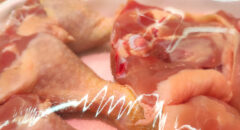
Is it true that bad looks can equal bad health? When your body is healthy, you tend to look attractive and more youthful.
But oddly, people tend to point their fingers at things like aging when it comes to less attractive things, like hair loss, unsightly nails and skin problems, according to Health.com.
Celebrate great health! LIKE BlackDoctor.org on Facebook!
In fact, these flaws can actually be signaling underlying health issues, says integrative medicine specialist Molly M. Roberts, M.D., of the Institute for Health & Healing, in San Francisco, and president of the American Holistic Medical Association.
“It’ll start by whispering, then it’ll start talking, and, if you don’t pay attention, it’ll start yelling and shouting, and then you’ve got an illness,” she says.
Here are just a few of the noticeable signs of potential health problems beneath your skin’s surface.
Hair Loss
The Problem: Thyroid disorder
Pregnancy, stress, disease, medications and changes in hormones all can contribute to hair loss. But among women in particular, dry, thinning hair may be a sign of an underactive or overactive thyroid. A simple blood test can check whether the body is making normal amounts of thyroid hormone.
Cracked Lips
The Problem: Sjögren’s syndrome
Severely cracked, dry lips may be a reaction to medication, an occupational hazard (if you’re a brass musician), or a symptom of allergy, infection or other conditions. Cracking at the corners of the mouth may also be a symptom of Sjögren’s (pronounced SHOW-grens) syndrome, an immune system disorder. Sjögren’s causes dry eyes and dry mouth, as well as joint pain and dry skin. As many as 4 million Americans — mostly women — have this condition.
Dark Skin Patches.
The Problem: Diabetes/Cancer
A ring of dark skin at the back of the neck may look like it’s crying out for a good scrubbing, but it may be acanthosis nigricans, a condition in which the skin appears darker and thicker — even velvety — along body creases. People with insulin resistance, diabetes, obesity or, in rare cases, cancer, can develop these dark patches. Although not a definitive sign of diabetes, “It makes you think twice and do more workup,” says Heather Jones, a nurse practitioner at Oregon Health & Science University, in Portland, and a member of the Dermatology Nurses Association board of directors.
The Problem: Heart disease
Bad teeth and gums aren’t just signs of poor oral hygiene. In 2010, Scottish researchers reporting in the British Medical Journal found that tooth brushing lowers the risk of heart disease. Tooth loss also can signal osteoporosis. Missing teeth may mean jawbone density can no longer support a mouthful of pearly whites.
Butterfly Rash
The Problem: Lupus
A rash is like a red flag. It’s your body’s way of saying that something is not right. There are all kinds of rashes, of course, but one in particular stands out. It stretches across both cheeks in the shape of a butterfly and has a sunburn-like appearance. This rash is a classic symptom of lupus, an immune-system disorder that affects the skin, joints, blood and kidneys.
Yellow Eyes
The Problem: Liver disease
In adults, eyes that are white instead of yellow can be a sign of liver disease, such as hepatitis or cirrhosis. It can also mean that the ducts that ferry bile away from the liver are blocked. Anyone with yellowing of the eyes should see their physician for further evaluation.
Swollen Feet
The Problem: Heart failure
Shoes too snug? Many conditions, including sprains, strains, injuries and infections, can cause feet and ankles to balloon, such as pregnancy, obesity and certain medications. However, certain diseases can cause fluid retention as well. If you’re one of the five million Americans with heart failure, you may be retaining fluid because of your heart’s poor pumping action. Swelling in the legs, ankles and feet is a classic symptom of this condition.
Unsightly Nails
The Problem: Psoriasis/Arthritis
Nails that are pitted, deformed or discolored (yellow-brown), or nails that thicken or separate from the nail bed, can point to many health problems, including psoriasis, arthritis and alopecia areata, a type of patchy hair loss. Pitting has also been reported in patients with Reiter’s syndrome, a type of arthritis, and incontinentia pigmenti, a genetic skin condition.
Excessive Body Hair
The Problem: PCOS
Hair where you don’t want it to be is embarrassing, but it also can be a sign of polycystic ovary syndrome (PCOS), a common cause of increased hair growth in women of childbearing age, can cause infertility and infrequent, irregular or absent periods. More than 70 percent of women with PCOS have hirsutism, or excess hair growth, typically appearing on the face, chest, stomach, back, hands or feet.








